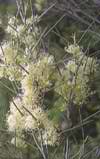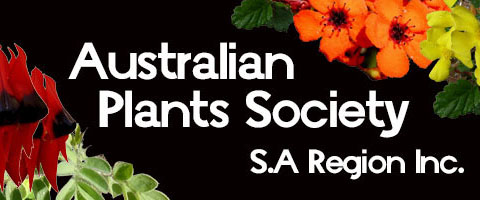Plants Used by the Adnjamathanha
from S.G.A.P Journal, January 1984, 9(2)
Below is a list of some of the more common plants to be found in the Flinders Range. The Adnjamathanha name is given and the traditional use for each plant is outlined. 'Adnjamathanha' is the name of the language spoken by the people living in the Flinders Ranges of northern South Australia.
Alku - Casuarina cristata
This tree grows to about five metres and has ascending striate branchlets which are smooth and which separate easily. The long branchlets, which look like pine needles, were chewed by the Aborigines to stimulate saliva flow, and in the drier months this practice helped allay thirst. The wood of the tree was sometimes used for making throwing implements such as woomeras.
Minera - Heterodendrum oleifolium
A tree about 4 metres high and grows though out the Flinders. The leaves of the tree are dark green-grey. The fruit was a source of food for the Aborigines. The wood was made into utensils and was often engraved and decorated.
Iga - Capparis mitchelii
This tree is found mainly in the northern part of the Flinders and is the object of an Adnjamathanha myth. This plant has large cream flowers and dark green-grey foliage. The fruit resembles a small domestic orange and is edible when fully ripened. The fruit has many seeds like a pomegranate.
 |
|
Hakea leucoptera Photo © copyright Ivan Holliday |
Vana - Hakea leucoptera
Found in the sandy regions of the Flinders. The leaves are long and come t a point. The Aboriginal people obtained water from the roots; this was done by cutting the roots so that the water could drip downwards into a container. The nuts or kernels were used for decoration.
Vatiwaka - Santalum lanceolatum
These trees grow in small groups throughout the Flinders. The bark of the tree was used for medicinal purposes. The bark was burnt into ashes and then mixed with animal fat or oil from nut kernels so forming a paste. This could then be applied to skin sores and cuts. These small trees grow to about four metres high with spreading branches. The leaves are pale green and taper to a short petiole.
Wira - Eucalyptus camaldulensis
Widely distributed in Australia and most often found along watercourses. The hard red timber was utilised by the people of the Flinders for many purposes. It was useful for making utensils such as bowls and digging sticks. Hollows in tree trunks were burnt out and used for shelter. The timber was particularly useful for fire making.
Nguri - Acacia calamifolia
Wattles are distributed widely throughout the Flinders. They provide a good supply of gum which is edible and which was used by the Aborigines as a form of glue.
Uti - Santalum acuminatum
Found in many localities in the Range. The trees grow to about three metres. They have long slender leaves with smooth grey stem or bark. This plant has bright red fruit which is edible when ripe. The fruit can also be used for making jellies or preserves, and the inside of the kernel can be eaten. Traditionally, the fruit was preserved by drying in the sun after the kernel had been removed. The peach was also used for decorations.
Ata - Xanthorrhorea quadrangulata
Widely distributed. Has a thick woody stem or trunk with a dense tuft of foliage at the top. These plants provided nectar from their many sweet flowers which appear in early autumn. To wipe off the nectar the Aborigines loosely wrapped a fibre around the neck of the flower and then moved up wards. The sap in the trunk was used as an adhesive in tool making. The soft wood of the flower spike was used by Aborigines in fire making, and the smoke was said to have relieved colds and blocked nasal passages and to have healed chest complaints.
Vatipi - Lysania exocarpi
This plant is a parasite and is to be found living off other trees throughout the Flinders. When ripe the berries are edible though rather sticky, and are coloured black as well as red. The seed or berries were used for adhesive purposes.
(the preceding article was taken from "The Flinders Range - An Aboriginal View", a publication of the Heritage Unit, Department for the Environment, South Australia)



